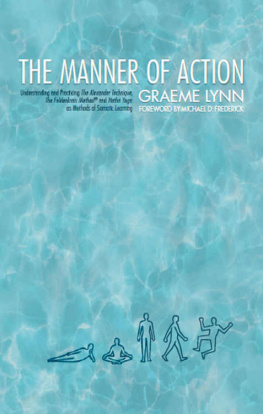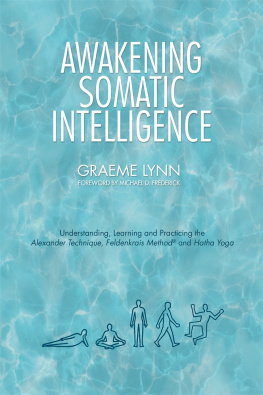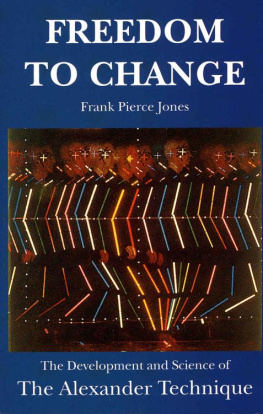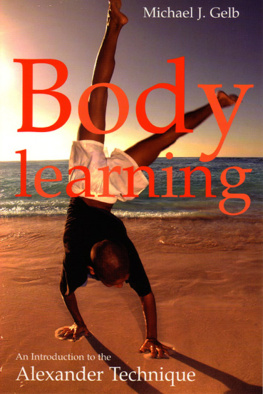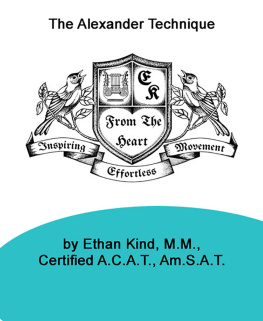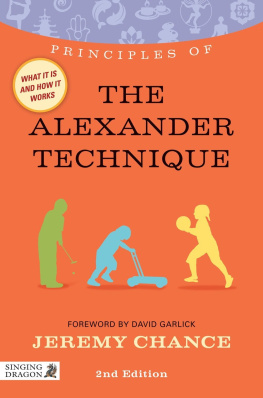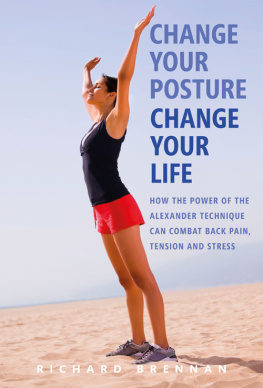MANNER
OF ACTION, The
Understanding and Practicing
The Alexander Technique,
The Feldenkrais Method
and the Hatha Yoga, as
Methods of Somatic Learning
by
GRAEME LYNN
Copyright 2015
By Graeme Lynn
(Library or Congress CIP here)
ISBN 9780828325899 Paperback
ISBN 9780828325905 E-Book
Branden Books
PO Box 812094
Wellesley MA 02482
www.brandenbooks.com
to
Emrys and Jonah
Table of Contents
PART 1: INTRODUCTION
Chapter 1. The Natural State 8
Chapter 2. The Infinite Network of Possibility 10
Chapter 3. Freedom from Reaction 13
Chapter 4. The Nature of Water 19
PART 2: SUMMARY VIEWS
Chapter 5. The Evolution of a Technique 24
Chapter 6. Essentials of the Work 34
Interlude: Relaxation
Interlude: The Fourteen Senses
Chapter 7. Structure, Function, Self-Organization & Use 44
Interlude: Yoga: Structure and Function
Chapter 8. Basic Coordination 50
Interlude: Motor Concepts and Percepts
Interlude: The Causes of Pain
Interlude: The Actural Dynamic
Interlude: The Hip Joints, The Movement of the Pelvis and Grounding
Interlude: More on Giving Directions
Chapter 9. Organizing Principles 69
Use
Attention
Intelligence
The Primary Control
Self-Contraction
Sensorimotor Unreliability
Interlude: Self-Correction
Intention
Holism
The Four Imaginary Centres
Interlude: The Frontal Line
Tensegrity
Habit, Learning & Freedom
PART 3: LESSONS
Chapter 10. A First Possible Lesson 85
Chapter 11. A Second (Impossible) Lesson 94
Chapter 12. Teaching Remarks 99
PART 4: MANIPULATIONS
Chapter 13. Evolutions 101
Positions of Mechanical Advantage
Elemental Movements
Applications
Interlude: Illustrations: Writing & Lifting
Interlude: Breathing
The Whispered Ah
Interlude: The Tarzan Breath
Hands on the Back of a Chair
Interlude: Patrick Macdonalds Approach to the Organization of Function
Interlude: An Alternative Approach
Chapter 14. Awareness Through Movement 116
Interlude: An Analysis of Movement
Interlude: Pain as Misinformation
Intelligence
Awareness
Release & Differentiation
Directed Movement
Interlude: Emergent Learning
Integration
Interlude: Table: ATM Strategies
Chapter 15. ATM Course: Intelligence in Action 139
Scans
Knee Circles
Arm Circles
Washrag
Pelvic Clock
Forward Bending
Cat & Cow
Ball of Air
Silly Walking
Twisting
Extending the Back
Back Roller
Opening the Legs
Crawling
Butt-Walking
Sitting Cross-legged
Serpentine Spine
Reaching with the Rib Cage
Bridging
Forward Roll
Sitting to Standing
Chapter 16. Hatha Yoga: A Somatic Approach 164
Interlude: Stretching Alignment & Symmetry
Interlude: Pain as Information
Interlude: General Instructions
Arc
Plough
Triangle
Reverse Triangle
Eagle
Twist
Cobbler
Cow
Gorilla
Handstand
Downward Dog
Lion
Forward Bend
Camel
Bridge
Head-knee pose
Candle
Corpse
PART 5: QUESTIONS & ANSWERS
Isnt good posture really just a matter of holding oneself properly?
Is the Alexander Technique a remedy for arthritis?
Will the Alexander Technique make me look better?
Can elderly people benefit from these methods?
Can chiropractic and massage help a bad back?
What about physical exercise?
My physiotherapist tells me to strengthen my abdominal muscles to stabilize my back: is that correct?
Can the Technique improve my golf game?
Will I always have to work on myself?
Can the Technique be useful in the field of healthcare?
PART 6: EPILOGUE
Chapter 17. Individual Practice 215
Interlude: The Bodily Patterns of Anxiety, Effort, Protection & Collapse
Chapter 18. Freedom in Action 219
Recommended Reading
PART 1: INTRODUCTION
Chapter 1. THE NATURAL STATE
I am describing your ordinary state. You are functioning as awareness, then intelligence, associated with mind, emotion and body. In the Hindu tradition, the structure is described in terms of sheaths, the more outer being the physical, then the dimensions of natural energy and the emotional aspects of the person, then mind-forms and the psychic life, then this intelligence that observes it and that should control it, and, deeper than that, the awareness itself. The body-mind is described from the periphery to the centre as a collection of sheaths, with awareness at the centre and the body and its field of activities at the periphery.
This is simply an educational model to help people understand just how they are functioning in ordinary terms.
Adi Da Samraj
Monk: How then do we attain freedom?
Master: From the first, we have never been in bondage,
and therefore there is no need to seek freedom.
Just use the ways of freedom, act in freedom
this is indeed incomparable.
per D. T. Suzuki
Apollo
We cannot know his mythic head
With eyes like ripening fruits,
And yet his torso, even now,
Is full suffused with brilliance like a lamp
In which his gaze, turned down to low,
Still gleams in all its power.
Otherwise the curving breast could not so dazzle us
Nor could a smile run through the placid hips and thighs
To that dark centre wherefrom all of procreation flares.
Otherwise the stone would seem defaced
Beneath the live translucent cascade of the shoulders,
Would not glisten like a wild beasts fur,
Would not from all the borders of itself
Burst outwards like a star.
For here there is no place that is not seen.
I must transform my life.
Rainer Maria Rilke
Chapter 2. THE INFINITE NETWORK OF POSSIBILITY
IMAGINE you are walking down a country road at dusk and, looking in the distance and through the dimming light, you see a darkened figure approaching you on foot. The shadows of the evening deepening into night conceal the clothes and persons features from the eye. How is it then you know and can recognize a friend?
You know because your friend and each of us organize ourselves in movement in a personally unique manner. This characteristic patterning derives in part from our inheritance but in larger measure from our experiential learning and we are active as that patterning, generally unconsciously, in everything we do. What we inherit through our family of origin in physical terms remains a subject of research: organic strengths and weaknesses, bone structure and body type, facial features and so forth. The means whereby we learn and all of what we learn in terms of action patterns, movement and coordination are a more complex matter. In Ida Rolfs text, The Integration of Human Structures , she tells the story of a man who suffered severe injuries to a leg and his pelvis in the Second World War and who, though he lived and was otherwise healthy, consequently walked with a pronounced limp. After the war he married and had a son. Remarkably, before the boy had reached puberty he limped in the same way as his father.
This is not some weird and isolated aberration. We are each of us alike that child in many complicated ways.
The ability of the human nervous system to learn, through which we adapt and change, is immense and subtle. We do not learn merely through imitation as in that story. Our physical development altogether, while guided genetically, is in part an open-ended process of functional learning. Our bodily expression of emotional character and fundamental beliefs is largely a matter of learning.
Next page
